When setting up an organization with family or friends it’s easy to assume that nothing can fail in the future.
You might assume that as you trust one another you do not need to put in place something like a shareholders’ agreement.
So, you might think that asking for a shareholders’ agreement will make it sound such as you don’t trust or respect your new business partners.
Hopefully, nothing will go wrong in the future. However, even members of the family and best friends fall out and, if the worst should happen, you may then find yourself with nothing.
Or you might face the breakdown of friendship alongside a costly and acrimonious legal dispute associated with the business.
If you are going into business with others and are looking for confidence about your future relationships with them, you should consider putting a shareholders’ agreement in place.
This also helps to protect both the business and your investment within the company.
You should always consult a lawyer though before finalizing any contracts.
In this article, I will explain shareholder agreement, the difference between shareholder vs stakeholder, its sample template, and some facts about it.
So, let’s get started.
Shareholder VS Stakeholder
Before diving deep into the concept of shareholder agreement you should be aware of who is a shareholder and stakeholder.
Well, a shareholder is a person who owns portions of equity, known as shares, in a corporation.
If the company performs well, the shareholders’ profit. If the corporate performs poorly, the shareholder can potentially lose money.
Always remember that shareholders are always stakeholders in a corporation, but stakeholders are not always shareholders.
A shareholder owns a part of a public company through shares of stock.
Whereas a stakeholder has an interest in the performance of an organization for reasons apart from stock performance or appreciation.
For example, if an organization isn’t performing financially, the vendors in that company’s supply chain might suffer if that organization no longer uses its services.
Similarly, employees of the corporate, who are stakeholders and trust it for income, might lose their jobs.
These reasons often mean that the stakeholder has a greater need for the company to succeed over an extended term.
What is a shareholder agreement?
A shareholder agreement is a document involving multiple shareholders of an organization.
This will include the precise outcomes and actions which will be taken in the event of a shareholder leaving the company, whether voluntarily, involuntarily, or if the corporate ceases trading.
It is a formal contract that sets out and explains the structure and nature of their relationship to the corporation and one another.
Corporations find this kind of agreement to be highly valuable because it helps to form a powerful foundation for the corporation as a whole.
The owners and directors of the company will interact with one another based on this agreement, so it needs to be strong, thorough, well thought out, and without loopholes, ambiguous wording, or other problems.
However, these agreements can also become too restrictive, so it is important to ensure that proper wording is provided and the parties to the agreement all understand what is being asked of them.
This agreement will identify the following basic elements:
- Who are the directors?
- Who are the shareholders?
- What happens if one dies.
- How shares are given to or sold to individuals.
- How shares are sold back to the company or others.
- Also, how dividends are paid from owning shares.
- Any other perks that are given to parties to the agreement.
- Any rights and responsibilities of the parties.
Insights about Shareholder Agreement
When Do I Need a Shareholder Agreement?
It’s highly advisable to put the agreement in place upon the formation and expansion of the company and the issuance of its very first shares if-
You Are A Corporation
Corporations will generally want to make a Shareholder Agreement. These are not legally required to form a corporation in all states, but they can and do offer protection and information that are both very valuable for shareholders and directors alike.
You Have Outside Investors
If the corporation plans to take money from outside investors, this document is needed.
Anyone who invests in a corporation will want to know how that corporation intends to use their money and what they will be getting for their investment.
They also want to know when they can expect dividends and anything else they are supposed to get from their shares.
In other words, without a clear document providing that information, they may choose not to invest.
Filing and Registration of Shareholder Agreement
You do not file a Shareholders’ Agreement. To register a corporation you need to file your Articles of Incorporation and make regular annual filings as requested but that is all.
Your Shareholders’ Agreement is an agreement between parties similar to the other business contract and is employed for internal purposes only. It should be stored in your minute book.
Consequences of Not Having a Shareholder Agreement
Even though this document is not required, there can be serious consequences for not having one available and in use.
Investors generally want to see a shareholder agreement
Investors are not usually comfortable with providing money to corporations that are not well organized.
Remember, investors invest because they see the value of doing so. When they no longer see that value, they can end up withdrawing their support.
Before they invest, they will carefully study the corporation so they can make a good decision that will benefit them in the short term and the long term.
Corporations without these agreements do not show investors what they need to see to feel comfortable with how they will get their investment back over time.
Disputes
Many agreements that belong to small corporations are only created when there is a problem developing.
Rather than allow things to get to that point, creating a Shareholder Agreement right away will reduce problems and the risk of disagreements down the line.
If there are disagreements at a later date, the agreement will be something that all of the shareholders and directors can be held to, so there are no legal ramifications from not having a proper agreement available.
Stabilization of Business
Most corporations understand that the best time to create this agreement is early on, but in some cases, they avoid making one. When they fail to create one, they generally find that they only need it when problems appear.
When it is created right from the beginning, everyone is agreeing to it on good terms. Strong-arm tactics are more common when shareholders are already struggling to get along with one another.
That can be a serious concern for all parties, but if there is no agreement in the beginning there is little that can be done once things go bad.
Shareholders Agreement vs Operating Agreement
An operating agreement is analogous to a shareholder agreement, but it’s tailored for an indebted company.
Instead of shareholders, the company has members.
The operating agreement appoints the manager, defines what happens in the event of an unexpected occurrence, just like the death or disability of a member, and sets forth a process by making an estate plan that defines how to handle things under various circumstances.
Like a shareholder agreement, the arrangements which will be established by an operating agreement are of infinite variety.
Key Provisions of a shareholder agreement
These are the three main key provisions:
Transfers of shares
Transfers of shared business owners can use shares of the corporate as an incentive for workers to dedicate themselves to the expansion of the business.
Although as a wonderful motivator, it’s going to end in an exceeding problem if the relationship deteriorates.
Structure a clause within the agreement to affect the fate of shares during this case.
Outline the worth of shares if sold within the corporate, which parties are or aren’t eligible to buy the shares, how the worth of the shares are going to be estimated and if an employee can keep his or her shares.
Dispute Resolution
Develop a provision to affect deadlocks between shareholders. In many cases, these clauses are often mentioned because of the “fundamental dispute” clause and are limited to deadlocks on fundamental issues like raising capital or changing the shares.
Restricted Activities
The Agreement can include the need for a “super-majority” of shareholders to form certain decisions.
In most cases, the majority shareholder has the facility to form decisions.
The inclusion of a “restricted activities” clause can outline the necessity for a selected percentage of shareholders (67 percent, 75 percent, etc.) to agree before ensuring decisions, like paying dividends.
Amending Shareholders Agreement
Amending a shareholders agreement covers stock transfer and ownership issues detailed within the document itself but the subject must be proposed in the meeting of the board of directors.
A majority of the administrators must agree that an amendment is suitable, and the board must record its decision to amend as an organization resolution.
If the bylaws require the choice to be accepted by a majority of the shareholders, the directors would call a shareholders meeting, at which they’d vote on the amendment.
The board would prepare the restated and amended shareholders agreement, vote it down, and preserve it within the corporate records.
Breach of Shareholders’ Agreement
Shareholders can breach the agreement by either making a call without the majority of votes or by selling or transferring assets without following the terms stated within the shareholders’ agreement.
So, if the shareholders’ agreement is breached, the document remains valid.
The shareholders who suffered damages due to the breaching shareholder can have a claim for breach of contract against the latter.
In this case, the available remedies will recover monetary damages, suspending the shareholder’s voting rights, or, obtaining an injunction.
One of the foremost common ways to prove that the breaching shareholder caused harm is to indicate that the consequence of his or her acts might be a loss and/or devaluation of the non-breaching shareholder’s shares.
S corp shareholder agreement
S corporations are corporations that elect to pass corporate income, deductions, losses, and credits through to their shareholders for federal tax purposes.
Shareholders of S corporations report the flow-through of losses and income on their tax returns. These are assessed tax at their taxation rates.
This allows S corporations to avoid double taxation on the company’s income. S corporations are liable for tax on certain built-in gains and passive income at the entity level.
Well, the S corp shareholder agreement is formed between the shareholders of an S corporation. The contents of the shareholder agreement are different from one S corporation to another.
The shareholders are also able to decide what goes into the shareholder agreement, which is also referred to as the stockholder agreement.
Typically, the shareholder agreement addresses share ownership, share valuation, and also the rights and responsibilities of the shareholder.
Corporations need to follow the rules established by the Internal Revenue Code to be able to make an election for Subchapter S.
These rules are related to the number of shareholders that a corporation can have as well as the type of shareholders.
S corporations need to meet the following guidelines:
- S corporations are not allowed to have more than 100 shareholders.
- An S corporation can only have one stock class, and therefore the 100 or fewer shareholders must be individuals or certain kinds of tax-exempt trusts or entities.
Parties of the Shareholder Agreement
The parties to a Shareholders’ Agreement constitute the shareholders of that organization. Ideally, all shareholders will participate in the Shareholders’ Agreement.
End of Shareholder Agreement
Just like any other contract, you have the choice to terminate a shareholder agreement. You can do this in 3 different ways:
Mutual termination
This is the first way you can terminate the agreement. Here, all of the involved shareholders must unanimously agree to no longer comply with the terms of the agreement even if they have different reasons.
Sometimes, the shareholders just want to sell their shares, the company might get dissolved soon, and more. Therefore, you must include such provisions in the document.
Automatic termination
This happens when a breach by any of the shareholders happens. In such a case, the agreement gets automatically terminated unless it contains clauses that set out some type of resolution or mediation.
Leaving the company
If one of the shareholders decides to leave the company, the agreement may get terminated. In such a case, there are specific provisions that describe what must happen..
The help of a shareholders’ agreement for the minority shareholder
Companies are generally run by majority decision.
Although the articles of association include provisions that protect the minority.
These may be changed via special resolution by holders of 75% of the voting shares.
Some laws provide limited protection to minority shareholders but these are often costly to enforce and should not achieve the desired redress.
Being a minority shareholder and having a shareholders’ agreement that features the necessity for all shareholders to approve certain decisions ensures that you simply have a say in the important decisions that impact the company.
This could be decisions on:
- The issue of new shares;
- Appointment or removal of directors;
- Taking on new borrowings; or
- Changing the main trade.
A minority shareholder might want a provision included that if someone is willing to buy the shares of a majority shareholder.
Then a shareholder can only sell the shares if the same offer is formed to all or any shareholders including the minority one.
This is often stated as a tag-along provision. This should then make sure that minority shareholders receive an equivalent return on their investment because of the other shareholders.
The help of a shareholders’ agreement for the majority shareholder
If a majority shareholder wants to sell their shares but a minority shareholder is unwilling to agree. So, including a provision forcing that shareholder to sell their shares is vital.
This is often stated as a drag-along provision.
Also, a majority shareholder would want to stop minority shareholders from passing on confidential company information to competitors or putting in rival businesses.
Another concern is where a minority shareholder could transfer their shares to anyone.
This could cause problems for the other shareholders.
This is especially if the sale is to a competitor or somebody else the other shareholders don’t want to attach the company.
To overcome these problems, shareholders’ agreements will often include rules around share sales and transfers.
This will include to whom shares are often transferred, on what terms, and at what price.
The help of a shareholders’ agreement for the two shareholders that own 50% each of the shares
Where you and your fellow shareholder own 50% each in a company it’s important to possess a dispute resolution provision included as you’ll fall out.
Without an agreed procedure to resolve disputes no decisions can be made leaving the company unable to operate.
Shareholder Relationships
The majority of relationships come through family or employees.
Family Members
A person may own a corporation, and decide to make their children and other family members shareholders.
By doing that, they give those family members shares of the corporation, which have value. But they also likely want to make sure they are keeping majority control over that same corporation, so they will need to:
- Be careful how many shares they give or sell.
- Not give too much to the same person.
- Pay close attention to buying/selling shares.
- Create restrictions to ensure they keep majority control.
Employee
Many corporations allow employees to purchase shares of the company.
Also, in some cases, those shares are gifted to employees for specific reasons or milestones.
The corporation must keep track of:
- Who is getting what shares.
- In what numbers.
- The power and relationship balance.
Things to include in Shareholder Agreement
This describes the number of shareholders and their respective shareholdings. This agreement should include:
- Issuing shares and transferring shares – including provisions to prevent unwanted third parties from acquiring shares, what happens to shares on the death of a shareholder, and how a shareholder can sell shares.
- Including any tag along or drag-along provisions.
- Providing some protection to holders of less than 50% of the shares – including requiring certain decisions to be agreed by all shareholders.
- Paying dividends.
- Running the company – including appointing, removing, and paying directors, frequency of board meetings, deciding on the company’s business, making large capital outlays, providing management information to shareholders, banking arrangements, and financing the company.
- Competition restrictions.
- Dispute resolution procedures.
Clauses In Shareholders’ Agreement
Let’s discuss the 10 most important clauses to include in the agreement.
Sweat Equity
As the limited funds are available to pay salaries, many start-up companies offer shares to co-founders and key staff who provide “sweat equity” rather than capital.
When properly used, offering shares can provide a robust incentive to commit and grow the business. If the business is eventually sold or listed on a stock market, these shares can make initial founders and staff very rich.
Allocating shares at an early stage provides tax advantages like an increase in the value of the shares is taxed at a lower rate.
Share Vesting
Under vesting clauses, a shareholder does not obtain the benefit of the shares until certain conditions have been satisfied, such as remaining with the business for a minimum period or achieving a specific milestone.
After those conditions are satisfied, the shares or a certain predetermined percentage of the shares will “vest” in the shareholder.
Otherwise, the corporate may have an automatic right to repurchase the shares.
Another issue is that if the corporate is acquired or a change of control occurs before all shares have vested. In that case, a “trigger” clause could also be included to accelerate the vesting of the shares upon such change.
A “double-trigger” clause may provide that the shares only vest if the shareholder is subsequently fired.
This is to make sure that they need an incentive to remain with the business after the acquisition.
Good and Bad Leavers
Good Leaver & Bad Leaver clauses define what to do when shareholders leave the corporate under different circumstances.
For example, Bad Leaver clauses are included if a shareholder is terminated for a material breach of his or her contract, misconduct, or before reaching a critical milestone.
So, they will need to transfer their shares back to the corporate at either the value they purchased them or the market price (whichever is lower).
Whereas, Good Leaver clauses are included if a shareholder gets terminated or leaves the corporate after the achievement of specific milestones, or they may be required to sell their shares to the company.
Pre-Emptive Rights and Anti-Dilution
Pre-emptive rights clauses reduce the efficacy of such methods by making the corporation first offer any newly issued shares to existing shareholders proportional to their existing shareholdings.
This will make sure that existing shareholders can participate in new share issues without being diluted.
This can also be an efficient method for the corporate to boost money.
This is because it incentivizes shareholders to speculate extra money into the business & stops them from being diluted.
Anti-dilution clauses are almost like pre-emptive rights.
But they enable a shareholder to issue new shares automatically without paying for them.
This can lead to founders losing control of their company if shares are subsequently issued at a significantly lower cost.
Restrictions on Transfer of Shares
This ensures that shares can’t be sold to an undesirable third party without first either allowing the corporation to search out a purchaser or offering them to the existing shareholders at the equal price offered to that third party.
If there’s a dispute over the value of the shares, it’s possible to provide for an independent valuation or a formula to see the fair value.
If the value is less than what was offered, the shareholder may withdraw their notice to transfer the shares.
Restrictions on transfers of shares do not apply if shares are transferred to a trust or shareholder’s family members.
Rights to Appoint Directors and Restrict Activities
Usually, a majority of shareholders (i.e. 51%) are required to appoint and remove directors from the board, which allows effective control of the company.
However, this implies that a minority shareholder won’t have the proper representation on the board.
This is despite the fact they may hold up to 49% of the shares.
In that case, a shareholder agreement may allow a minority shareholder to appoint a director if they hold a minimum percentage of shares (e.g. 25%).
A restricted clause during a shareholder agreement requires a super-majority of shareholders before ensuring decisions.
These decisions are stepping into a transaction, paying dividends, or issuing more shares.
This can make sure that minority shareholders still have some control over the governance of the corporate.
I would recommend you consider seeking legal advice if you are not sure which provisions to include in which documents.
Liquidation Preferences
Liquidation Preference Shares are often issued to investors.
This is because if the corporate is sold or liquidated they’ll be the first in line to recover their investment before the other parties.
So, investors may negotiate on liquidation preference and will try to recover 2 or 3 times their investment.
This takes place before the remaining assets are distributed.
This could end with the other shareholders receiving a far smaller amount upon an exit.
Liquidation preferences for investors are reasonable, but if they exceed 1x this could be a red flag.
Debt and Equity Capital
Instead of receiving shares, a founder or investor may make a loan to the corporate.
This could convert into shares at a later date & is often stated as a convertible note.
A loan must be repaid beforehand of other shareholders (including any applicable interest).
This might provide him or her with the flexibility to get over control of the company to repay the loan.
Also, even sell the assets of the company to a distinct company related to that shareholder.
This can be contrasted with equity capital, which happens where shares are received in exchange for cash.
Fundamental Disputes
Sometimes, disputes between shareholders boil to such an extent that a deadlock occurs which is incapable of resolution.
Also, it has the potential to cause serious injury to the business as a going concern.
This could include a dispute over additional funding, a rise or reduction of shares, payment of dividends.
This could also include disagreement regarding the sale of the business.
In this case, a “fundamental dispute” clause is included to provide an exit strategy for one or more shareholders.
There will be an independent valuation as discussed above concerning restrictions on the transfer of shares.
Sample Shareholder Agreement Template
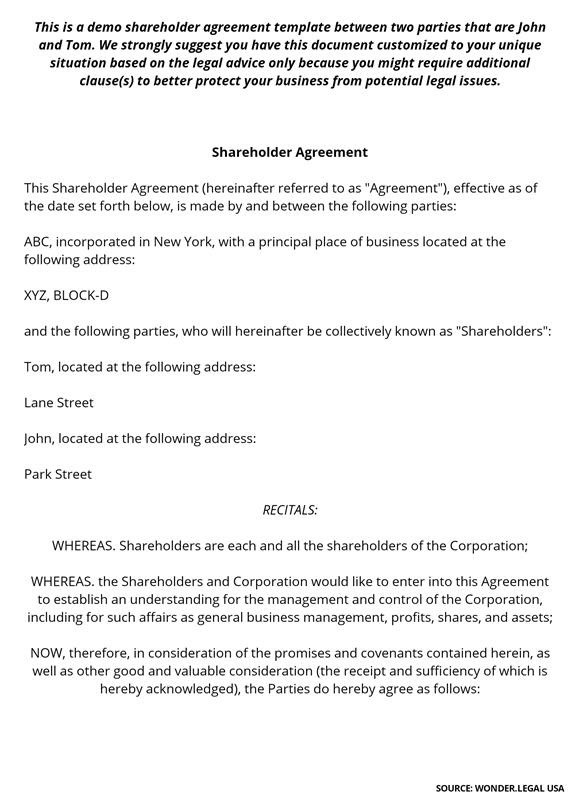

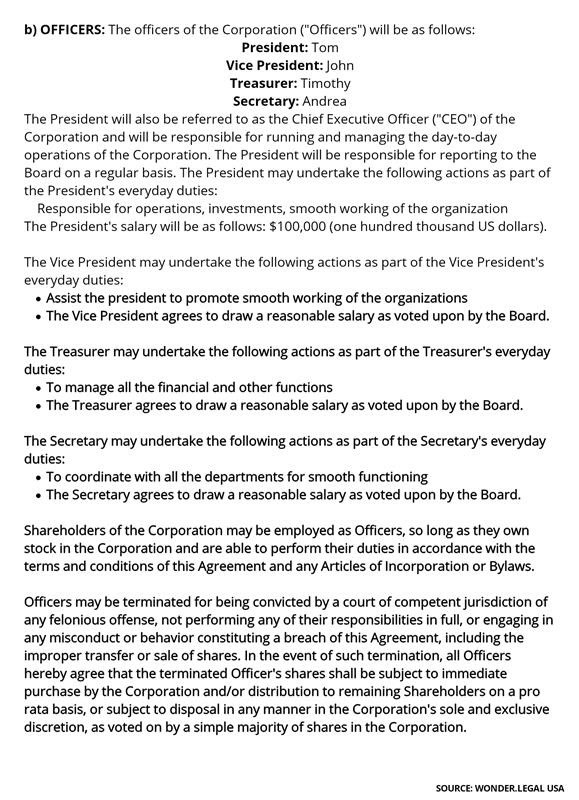
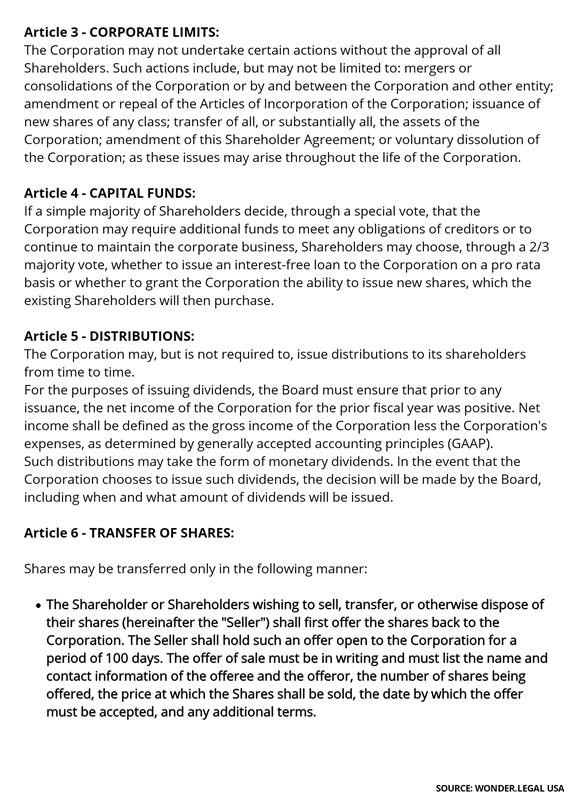
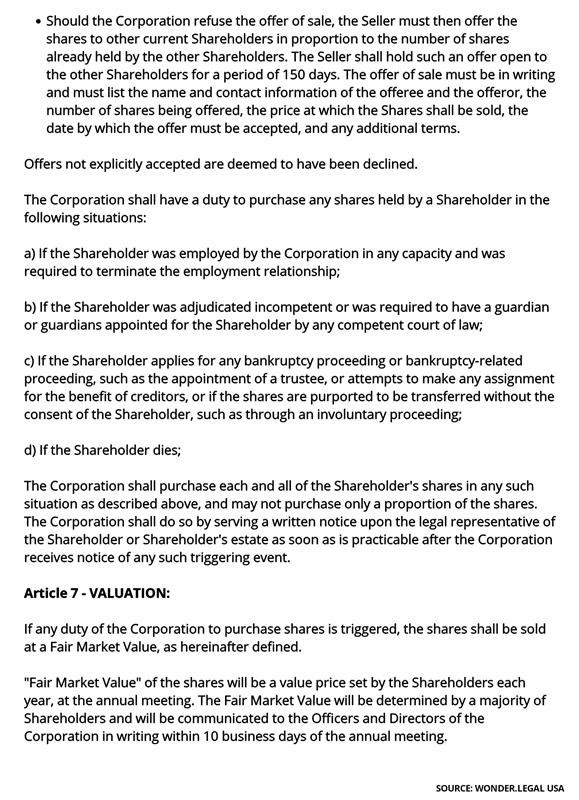

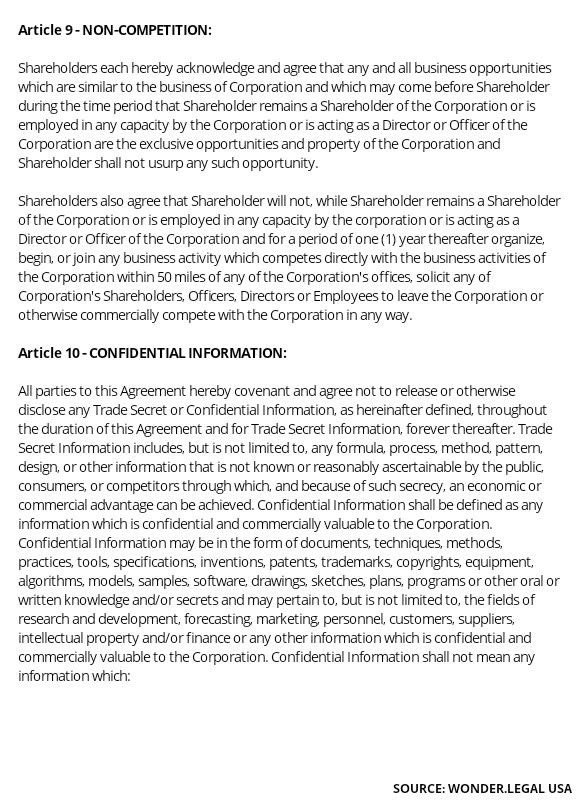
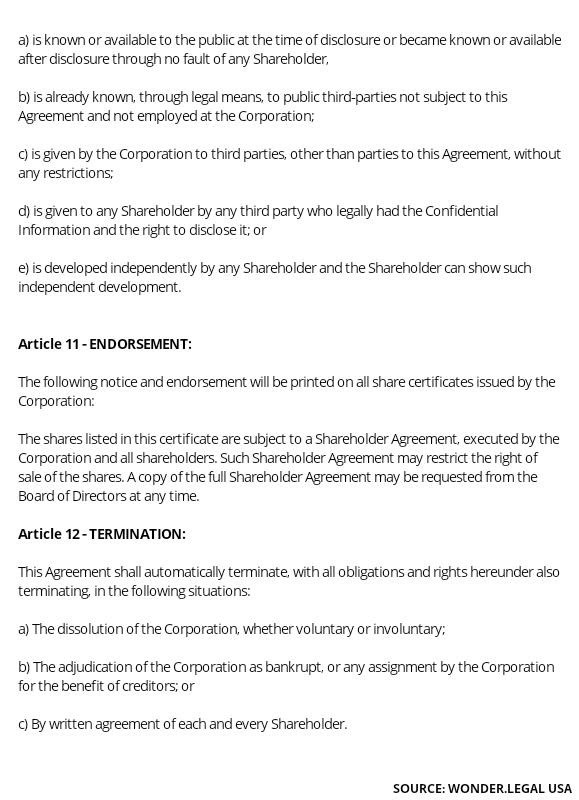

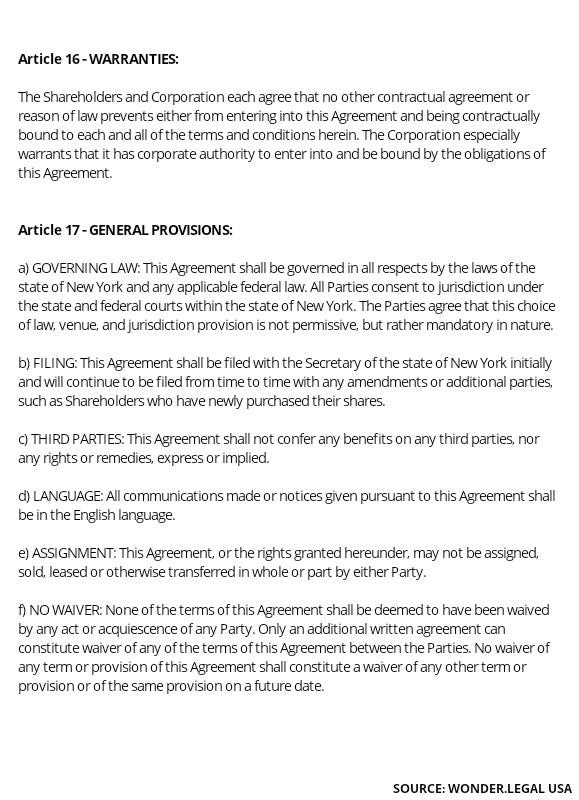

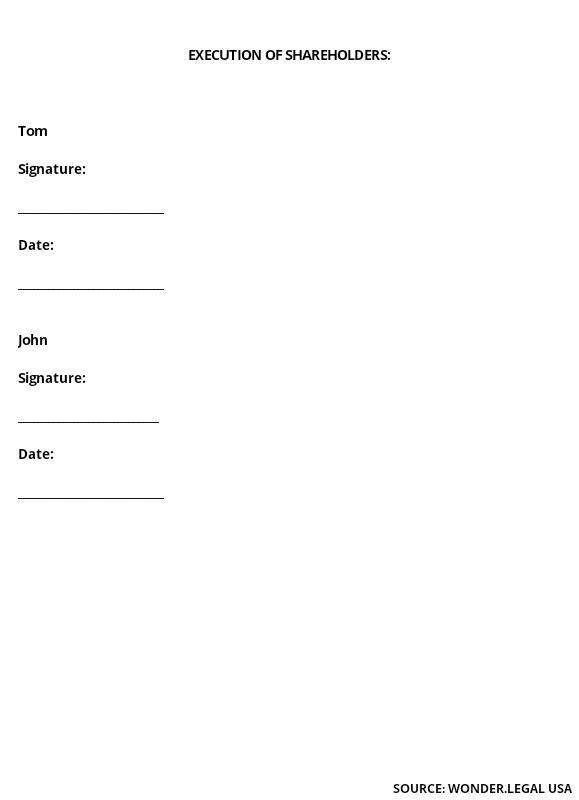
Conclusion
When it comes to corporations, their shareholders must know what they are required or not required to do.
This helps them in making decisions based on erroneous information.
A provision for other shareholders to buy the shares of those deceased or retiring is included in this agreement.
This helps to make sure these shares can be dealt with and valued appropriately.








